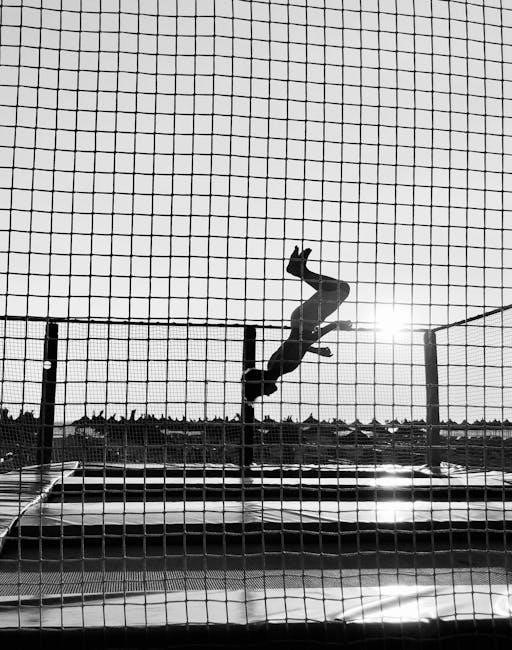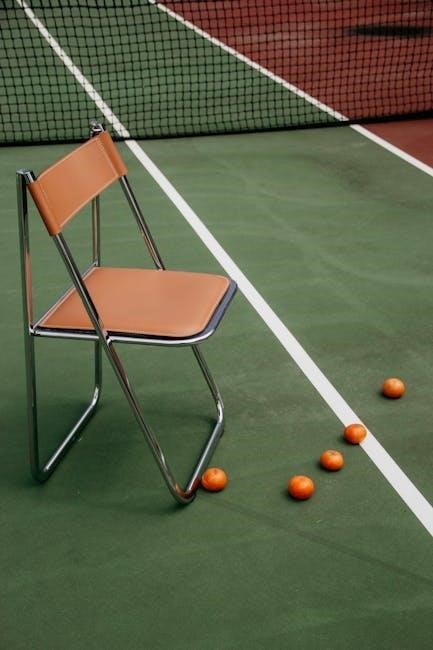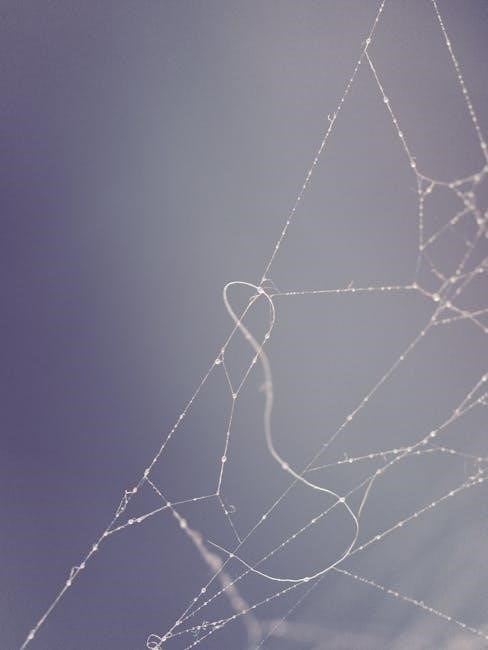
Installing a trampoline net is vital for ensuring jumper safety and preventing accidents. This guide provides easy-to-follow steps to secure your net properly, guaranteeing fun and peace of mind.
Importance of Trampoline Net Safety
A trampoline net is essential for preventing falls and injuries while jumping. It creates a safe boundary, ensuring jumpers stay within the trampoline’s perimeter. Nets also protect against accidental collisions with the frame or poles. While not mandatory, they significantly reduce risks, especially for children. Installing a net provides peace of mind for parents and promotes a secure environment for fun. Regular inspection and proper installation of the net are crucial to maintain its effectiveness and ensure safe trampoline use for everyone.
benefits of Using a Trampoline Net
Using a trampoline net offers numerous benefits, primarily enhancing safety by preventing falls and injuries. It provides a secure boundary for jumpers, reducing the risk of accidents and giving parents peace of mind. The net also protects users from colliding with the trampoline’s frame or poles. Additionally, it helps contain children within the jumping area, minimizing supervision needs. A net can also extend the trampoline’s lifespan by shielding it from debris. Overall, a trampoline net is a practical and essential accessory that promotes safe and enjoyable bouncing experiences for the whole family.
Preparation for Net Installation
Before installing a trampoline net, ensure you have all necessary components, including poles, connectors, and netting. Measure the trampoline to confirm the net’s compatibility and gather tools like gloves, a ladder, and wrench. Clear the area around the trampoline to prevent obstacles during installation. Check the poles for any damage and ensure they are the correct style for your trampoline model. Lay out the net and poles nearby for easy access. Wear gloves for a better grip and to protect your hands. Proper preparation ensures a smooth and efficient installation process, minimizing potential challenges.

Understanding Trampoline Net Components
A trampoline net system includes the enclosure net, lower and upper poles, pole caps, ropes, and PVC sleeves. Each part ensures stability and safe jumping conditions.
Key Parts of a Trampoline Net System
A trampoline net system consists of essential components like the enclosure net, lower and upper poles, pole caps, ropes, and PVC sleeves. The net provides a safety barrier, while the poles offer structural support. Pole caps secure the net to the poles, and ropes tighten the net for stability. PVC sleeves protect the net from friction and wear. Together, these parts ensure a secure and durable setup, preventing accidents and enhancing jumping safety. Proper installation and alignment of these components are crucial for optimal performance and long-term reliability.
Types of Trampoline Nets: Inside vs. Outside
Trampoline nets come in two main types: inside and outside configurations. Inside nets are attached directly to the trampoline’s mat, offering enhanced safety by reducing the jumping area and preventing users from touching the springs. Outside nets, on the other hand, are mounted around the trampoline’s perimeter, providing a larger jumping space but with a slightly higher risk of collision with the enclosure poles. The choice between the two depends on safety preferences and jumping styles, with inside nets prioritizing safety and outside nets offering more space for dynamic movements.
Materials and Durability Considerations
Trampoline nets are typically made from durable materials like polyethylene or polyester, designed to withstand outdoor conditions. Polyethylene nets are UV-resistant and suitable for harsh weather, while polyester offers breathability and strength. The mesh size and weaving tightness are critical for safety, as they prevent fingers or clothing from getting caught. Heavy-duty stitching and reinforced seams ensure longevity. When choosing a net, consider factors like weight capacity and the number of users. Durable materials and proper construction are essential for maintaining the net’s integrity and ensuring safe jumping experiences. Investing in a high-quality net is crucial for long-term safety and performance.

Step-by-Step Trampoline Net Installation Guide
This guide offers a clear, step-by-step approach to installing your trampoline net safely and securely. Follow these instructions to ensure a proper setup and enjoy worry-free jumping experiences.
Assembling the Pole Structure
Begin by gathering all pole parts and hardware. Identify the types of poles (aluminum or steel) and their designated connections. Attach the bottom ends of the poles to the trampoline base using nuts and bolts. Ensure they are tightly secured for stability. Next, slide the top sections of the poles into their respective connectors or sleeves. For straight poles, connect them to the base and align them upright. For curved or arched poles, follow the manufacturer’s instructions to lock them into place. Double-check that all joints are snug and the structure stands firmly. A sturdy pole structure is essential for safely securing the net.
Attaching the Net to the Trampoline Base
Once the pole structure is secure, lay the trampoline net flat around the base. Ensure the net is properly aligned with the trampoline’s circumference. Locate the attachment points on the net, such as loops or straps, and align them with the base’s hooks or connectors. Use the provided straps or ropes to tie the net firmly to the trampoline frame. Start by securing the net at the entrance point and work your way around, tightening each connection as you go. Make sure the net is taut and evenly spread to prevent sagging. Proper alignment is crucial for a safe and secure setup.
Securing the Net to the Poles
After attaching the net to the trampoline base, slide the poles into the net’s sleeves or hooks, ensuring they fit securely. Use the provided straps or ropes to tie the net to the poles, starting from the bottom and working upwards. Tighten each connection firmly to ensure the net is taut and evenly spread. Avoid sagging by checking each section as you go. For added stability, make sure the net is snug against the poles and evenly distributed around the trampoline. Properly securing the net to the poles ensures a safe and stable jumping environment for users of all ages.
Tying the Net with Durable Knots
Securing the net with durable knots is essential for safety. Use a square knot or lark’s head knot to attach the net to the poles. Ensure the knots are tight and evenly spaced. Check each knot after tying and pull the net firmly to verify tension. For added security, wrap the excess rope around the pole and tie another knot. Regularly inspect the knots to ensure they remain secure over time. Proper knot-tying ensures the net stays in place, providing a stable and safe environment for jumpers.
Finalizing the Installation
After securing the net to the poles, inspect the entire setup to ensure all connections are tight and properly aligned. Double-check that the net is evenly spread and free from wrinkles or sags. Test the stability by gently tugging on the net and poles. Ensure the entrance zipper is securely closed and functional. Finally, walk around the trampoline to confirm that the net is evenly distributed and all safety features are intact. This final inspection guarantees a safe and enjoyable jumping experience for everyone. Once satisfied, your trampoline is ready for use!

Troubleshooting Common Issues
Common problems during net installation include misalignment, loose connections, and sagging. Addressing these promptly ensures safety and optimal performance for a secure jumping environment.
Aligning the Net Properly
Aligning the trampoline net correctly is crucial for safety and functionality. Start by laying the net evenly around the trampoline, ensuring it is centered and symmetrical. Check for any wrinkles or twists that may cause misalignment. If the net seems uneven, adjust the poles slightly to balance the structure. Use the trampoline mat as a guide to ensure the net hangs evenly on all sides. Tighten any loose connections and verify that the net is securely attached to the poles and trampoline base. Proper alignment prevents sagging and ensures jumpers stay within the safe zone during use.
Dealing with Loose or Sagging Nets
If your trampoline net is loose or sagging, tighten the straps or ropes that secure it to the poles and trampoline base. Check for any worn or frayed straps and replace them if necessary. Adjust the net’s positioning to ensure even tension, preventing it from drooping. Tightening the connections between the net and poles can restore stability. Regularly inspecting and maintaining the net’s attachments will help prevent sagging and ensure a safe jumping environment. Proper tension is key to maintaining the net’s effectiveness and extending its lifespan.
Fixing Tears or Holes in the Net
To repair tears or holes in your trampoline net, start by assessing the damage. For small holes, use a patch kit specifically designed for netting. Turn the net inside out for easier access. Sew around the edges of the tear with a heavy-duty needle and thread, then apply waterproof glue to seal and reinforce the area. Allow the glue to dry completely before reusing the net. Regular inspections after repairs are crucial to ensure the net remains secure and safe. If the damage is extensive, consider replacing the net to maintain jumper safety and prevent further issues.

Maintenance and Care Tips
Assess the damage and use a patch kit or heavy-duty thread to sew small tears; Apply waterproof glue to seal and reinforce the area. For larger holes, consider replacing the net for safety.
Cleaning the Trampoline Net
Regularly cleaning the trampoline net is essential for maintaining its durability and appearance. Use mild soap and lukewarm water to gently scrub the net, avoiding harsh chemicals. A soft-bristled brush can help remove dirt without damaging the material. Rinse thoroughly with clean water and allow it to air dry. Avoid using bleach or abrasive cleaners, as they can weaken the net’s fibers. For tougher stains, apply a fabric-safe cleaning solution and rinse promptly. Cleaning the net regularly prevents mold and mildew buildup, ensuring a safe and clean environment for jumpers.
Inspecting the Net for Damage
Inspecting the trampoline net for damage is crucial for maintaining safety and durability. Regularly check for tears, holes, or frayed edges, as these can weaken the net’s integrity. After severe weather or heavy use, examine the net closely. Look for signs of wear, such as loose threads or fading, which may indicate aging. Test the net’s stability by gently tugging on it to ensure it’s securely attached to the poles. Address any damage promptly to prevent further deterioration. Small tears can be repaired with patch kits, but significant damage may require a replacement. Regular inspections help ensure a safe jumping environment.
Storage Tips for Off-Season
Proper storage of your trampoline net during the off-season ensures its longevity and prevents damage. Detach the net from the trampoline and poles, and store them separately in a dry, clean area. Avoid folding the net, as this can cause creases or tears; instead, roll it neatly. Use a sturdy storage bag or cover to protect it from dust and pests. Keep the poles in a upright position or lay them flat in a secure location. Ensure all hardware, like clips and straps, are securely stored to avoid loss. Regularly inspect stored items for moisture or damage to maintain their condition.

Choosing the Right Trampoline Net
Selecting the correct trampoline net ensures safety and durability. Consider size, material, and compatibility with your trampoline model to make an informed decision and ensure proper fitment.

Measuring Your Trampoline
Accurate measurement is crucial for selecting the right net. Measure the trampoline’s diameter or length and width for rectangular models. Count the number and style of poles to ensure compatibility. Record these details to match the net’s specifications. Proper fit prevents sagging and ensures safety. Use a tape measure for precise dimensions. Note the shape—round, square, or rectangular—and the size in feet. This step guarantees the net fits securely, providing optimal safety and durability. Always refer to the manufacturer’s guidelines for specific measurement instructions to avoid errors. Correct measurements ensure a perfect fit and safe jumping experience for everyone.
Compatibility with Trampoline Models
Ensuring the net is compatible with your trampoline model is essential for installation and safety. Check the trampoline’s specifications, such as shape, size, and pole configuration. Nets are designed for specific models, like Skywalker or Bounce Pro, and may require particular pole styles. Verify if the net fits straight, curved, or arched poles and matches the trampoline’s shape (round, square, or rectangular). Compatibility ensures a secure and stable setup, preventing gaps or loose connections. Always refer to the manufacturer’s guidelines to confirm compatibility, as mismatched components can compromise safety and functionality. Proper compatibility guarantees a safe and enjoyable jumping experience.
Price and Quality Considerations
Trampoline nets vary in price, typically ranging from $30 to $200, depending on size, material, and brand. High-quality nets made from durable materials like polyethylene or polyester are more expensive but offer better longevity and UV resistance. Cheaper options may compromise on strength and safety. When choosing, consider the trampoline’s size, shape, and pole configuration to ensure compatibility. Look for features like secure buckles, tight stitching, and weather-resistant coatings. Investing in a reputable brand, such as Skywalker or SkyBound, ensures reliability and safety. Always check for certifications like ASTM to guarantee quality and durability, making it a worthwhile investment for years of safe use.

Advanced Tips for Net Installation
Use gloves for a better grip, ensure tight fastening, and test stability post-installation for maximum safety and durability of your trampoline net.
Using Gloves for Better Grip
Wearing gloves during trampoline net installation is highly recommended to ensure a firm grip on poles and netting. Gloves prevent hand slippage, especially when handling smooth or wet surfaces, reducing the risk of accidents. They also protect your hands from abrasions caused by rough materials or sharp edges. By improving dexterity and control, gloves help you tighten straps and knots more effectively, ensuring a secure and stable net setup. This simple precaution enhances safety and efficiency, making the installation process smoother and less strenuous. Always prioritize hand protection to achieve a professional-grade trampoline net installation.
Ensuring Tight and Secure Fastening
Tightening all connections and fasteners is crucial for a safe and durable trampoline net setup. Begin by ensuring poles are firmly attached to the trampoline base using nuts and bolts. Next, secure the net to the poles with sturdy straps or ropes, tightening them evenly to avoid sagging. Double-check each knot and connection to ensure they can withstand repeated use. Properly tightened fasteners prevent the net from loosening over time, reducing the risk of accidents. Regular inspections and adjustments are also essential to maintain a secure setup, ensuring years of safe and enjoyable trampoline use for everyone.
Testing the Net’s Stability
After installing the trampoline net, it’s essential to test its stability to ensure safety. Start by gently tugging on the net from various points to check for any looseness or weak spots. Jump lightly on the trampoline to observe how the net responds to movement. Ensure the net doesn’t sag or stretch excessively, as this could compromise its protective function. Also, verify that the poles remain upright and securely attached to the trampoline base. A stable net will provide reliable support and prevent accidents, giving you peace of mind while enjoying the trampoline with family and friends.

DIY vs. Store-Bought Nets
DIY trampoline nets are cost-effective and customizable but require effort and materials. Store-bought nets offer convenience, durability, and safety guarantees, making them a popular choice for many families.
Pros and Cons of DIY Nets
DIY trampoline nets offer cost savings and customization but require time and effort. They allow a perfect fit but pose risks like measurement errors and weaker durability. No warranties are provided.
Advantages of Store-Bought Nets
Store-bought trampoline nets offer superior durability, safety, and convenience. They are designed to meet safety standards, ensuring secure and reliable performance. Pre-made nets often come with warranties, providing peace of mind. Installation is typically straightforward, with clear instructions. Additionally, they are made from high-quality materials, such as UV-resistant polyethylene, ensuring longevity. Many models are ASTM-certified and include features like no-gap designs and heavy-duty stitching. Popular brands like Skywalker and SkyBound provide compatibility with various trampoline models, making them versatile. Store-bought nets are a hassle-free choice, saving time and effort compared to DIY options while offering enhanced safety and durability.
Customizing Your Trampoline Net
Customizing your trampoline net allows you to tailor it to your specific needs and preferences. You can choose materials like durable nylon or polyester for weather resistance. Sizes can be adjusted to fit various trampoline models, ensuring a perfect fit. Additional features such as zipper styles, buckle types, and entry points can be personalized for convenience and safety. Some nets offer color options to match your backyard decor. DIY modifications, like adding reinforced stitching or custom pole setups, are also possible. Customization ensures your net is both functional and aesthetically pleasing, enhancing the overall jumping experience while maintaining safety standards.

Removing and Reinstalling the Net
Detaching the net from the trampoline involves removing pins or straps and carefully sliding poles out. Reinstallation requires aligning poles and securing the net tightly to ensure stability and safety.
Detaching the Net from the Trampoline
Detaching the net is straightforward but requires care to avoid damage. Begin by locating the attachment points where the net connects to the trampoline or its enclosure poles. Depending on the model, these may be secured with straps, buckles, or pins. Release the straps or remove the pins, working your way around the perimeter. For models with poles directly attached, slide them off after releasing any locking mechanisms. Once detached, carefully gather the net to prevent tangling. Store the net and poles separately in a dry place to maintain their condition. This process ensures easy reinstallation when needed again.
Storing the Net and Poles
Proper storage of the trampoline net and poles is essential to maintain their condition. After detaching, clean the net to remove dirt or debris. Allow it to dry completely to prevent mold or mildew. Fold the net neatly and store it in a protective bag or bin. Poles should be disassembled if possible and stored separately to avoid damage. Keep all components in a cool, dry place, away from direct sunlight. This ensures the net and poles remain durable and ready for future use. Proper storage also prevents tangling and extends the lifespan of your trampoline netting system.
Reinstalling the Net After Storage
When reinstalling the trampoline net after storage, begin by inspecting for any damage or wear. Lay out the net and poles to ensure all parts are accounted for. Reattach the poles to the trampoline base securely, following the manufacturer’s instructions. Spread the net evenly, aligning it with the poles. Use durable straps or ropes to tie the net to the poles, ensuring tight and secure fastening. Double-check all knots and connections for stability. Finally, test the net by gently tugging on it to ensure it’s firmly in place. Proper reinstallation ensures safety and optimal performance for jumpers.
Properly installing and maintaining a trampoline net ensures safety and longevity. Always follow instructions and inspect regularly for damage. Happy jumping with peace of mind!
Encouragement for Safe Trampoline Use
Encouraging safe trampoline use is essential for protecting jumpers of all ages. Always prioritize proper net installation and regular inspections to ensure a secure environment. Supervise children during use and teach them safe jumping practices. By following these guidelines, you can create a fun and protected space for family and friends to enjoy. Remember, safety measures like nets and proper maintenance are key to preventing accidents and fostering confidence. With a well-installed net and responsible habits, your trampoline can become a source of endless enjoyment and memories for years to come.